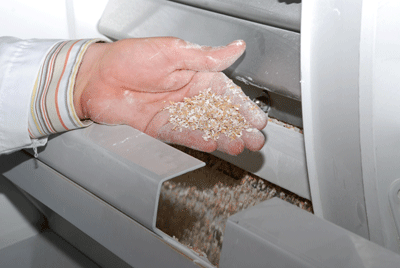Measuring quality in every scoop
ONTARIO WHEAT QUALITY IS MEASURED SWIFTLY AND EFFECTIVELY AT HARVEST TIME
for better or for worse, the quality of the Ontario wheat crop will fluctuate from year to year. Small changes in variables such as seeding date, temperature, and precipitation will either increase or decrease its end-use potential. For example, warm and dry weather during the growing season will typically lead to a higher quality and quantity of protein in wheat, while wet and cool conditions at harvest may increase the incidence of degrading factors such as Fusarium and mildew.
Scientists examine wheat at the CIGI facilities in Winnipeg

The fact that there will always be some variability in the Ontario wheat crop from year to year makes it imperative to our end users that we have a program in place for assessing the quality of the crop as soon after harvest as possible. It is out of this necessity that the Ontario Wheat Quality Scoop Program was developed.
As a joint effort between Grain Farmers of Ontario (GFO) and the Canadian International Grains Institute (CIGI), the Ontario Quality Scoop Program is designed to provide wheat quality information to Ontario wheat producers, marketers, and processors. Timeliness, representative sample collection and coordination are all key to making this program successful.
working around the clock
As soon as wheat harvest starts, everyone is anxious to know if the quality is going to match predictions made during the growing season. For the producer, quality will affect farm gate receipts; for the marketer, quality may determine the ease in which the wheat can be moved into higher value domestic and international markets; for the processor, quality will affect their processing procedures and end product.
In other words, everyone has something at stake so the sooner they have a handle on the quality, the sooner they can develop a plan for the movement and utilization of the crop. Therefore, sample collection for the Ontario Quality Scoop Program commences as soon as the first wheat deliveries hit the elevators and terminals.
well represented
Representative sample collection will accurately portray the overall wheat crop grown in a particular region. In order to obtain these samples it is vital to select sample collection points that are situated in the major wheat growing regions in Ontario. Since quality can vary from field to field it is also important to ensure that these samples are from a variety of fields within a particular region. Typically, when a delivery comes into a collection point, a 500 to 750 gram sample is taken and the date, location, class and variety are recorded. The number of samples collected and the number of collection points is in proportion to the historical wheat production numbers in that region.
working together
In order to maximize the value of the Ontario Quality Scoop Program it is essential to have a high degree of coordination between the elevators, sample collectors and the analytical, milling and baking facilities at CIGI. A great deal of work goes into generating wheat quality information in an expedited manner and it all begins with sample collection. During the harvest period, sample collectors will make the rounds to collection points at various intervals to ensure that any weather changes affecting quality during harvest are accounted for in the final results.
Once the desired number of samples are collected they are shipped off to CIGI’s Winnipeg facilities where they are cleaned and sent to grading. Once that is completed, the samples are blended into composite samples based on their grade and location. The composite samples then undergo a series of quality tests, which generate a wide range of data used to determine the wheat’s quality and ultimately its suitability for a variety of end-use applications.
Once all of the raw data has been collected, it is put together into a brief report detailing the overall quality of the Ontario wheat crop. The Quality Scoop report is primarily used by Ontario wheat marketers and end-users, but is available to anyone who is interested through the GFO?website. Information on the quality testing as well as last year’s Ontario Quality Scoop data can be found at www.cigi.ca or www.gfo.ca. •







